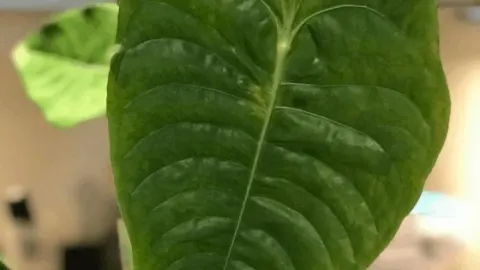Anthurium Veitchii is often referred to as the King Anthurium veitchii. After I have written one of the last articles about the Queen Anthurium (Anthurium warocqueanum), it is time for the King.
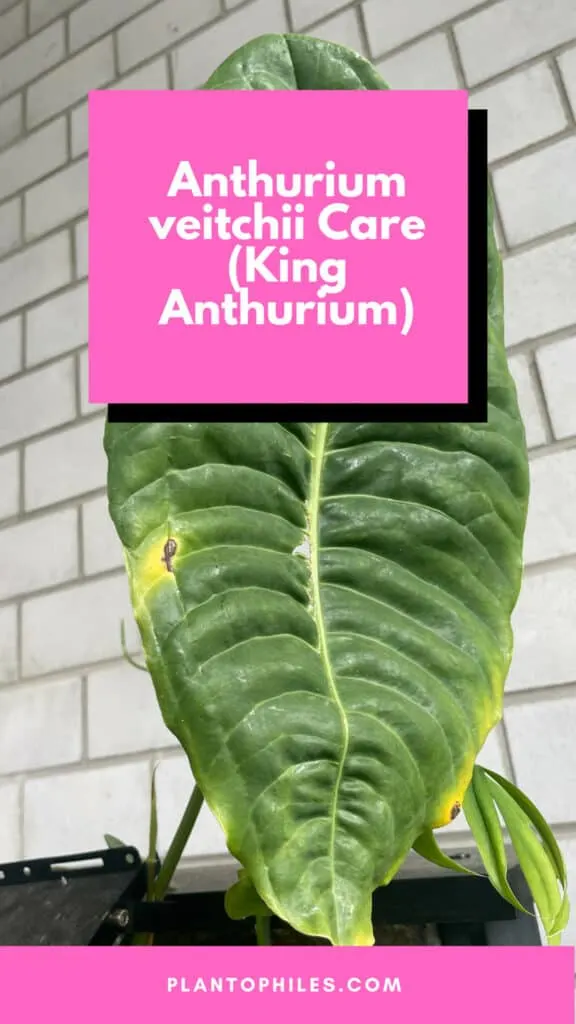
Table of Contents
What is the Anthurium veitchii King Plant?
The Anthurium veitchii is also called King Anthurium. There is a wide and narrow form. The plant grows in a cluster with large and long leaves.
The Veitchii is native to the South American Rainforests of Columbia. It is an epiphyte growing on other trees in nature. It belongs to the Aroid family (Araceae).
This plant gets humongous leaves up to 6.6 feet (2 meters) long. The leaves are strongly corrugated and look somewhat like nice abdominal abs.
Read now about growing Anthurium veitchii.
Anthurium veitchii King Takeaways
| Species | Anthurium veitchii |
| Synonyms | King Anthurium, Anthurium veitchii King |
| Family | Araceae |
| Genus | Anthurium |
| Growth | Pendant leaves growing from a crown |
| Height | 6 feet |
| Width | 2 feet |
| Soil | Well-draining potting mix consisting of potting soil, perlite, orchid bark and peat moss |
| Watering | Every 5 to 7 days |
| Light | Bright indirect |
| Temperature | 59 - 79°F |
| Humidity | 60 to 80% |
| Fertilizer | Fertilize once a month |
| Propagation | Division |
Anthurium veitchii Care Guide
Soil
Anthurium Veitchii is an epiphyte. This means it is a plant growing on other trees without soil.
Epiphytes get their nutrients from the wind, rain, and debris such as leaf litter in tree branches.
The conditions of how the Anthurium Veitchii lives in nature heavily influences how these plants are best cared for as houseplants.
The Veitchii is an aroid. Aroid plants develop a spathe and a spadix. This group of plants consists of the genus Monstera, Philodendron, Anthurium, and many others.
These plants need very airy soil that is well-draining. This allows air pockets to form as roots need air circulation to not develop root rot.
You can look at my article on how to come up with an airy soil mix.
General soil ingredients that lead to a great mix for aroids are:
- Perlite
- Orchid bark
- Peat moss or Coconut coir
- Sphagnum moss
- Activated charcoal
- Volcanic rock
Perlite and Orchid bark, volcanic rock, and activated charcoal will ensure the mix is airy and well-draining. Peat moss, as well as Coconut coir, ensure that the soil mix retains moisture and nutrients. Charcoal is a great way to increase the airiness of the soil further and remove bad smells and toxins.
A different approach is to grow Anthurium Veitchii in 100% Spaghnum moss. This is how I grow my King Anthurium.
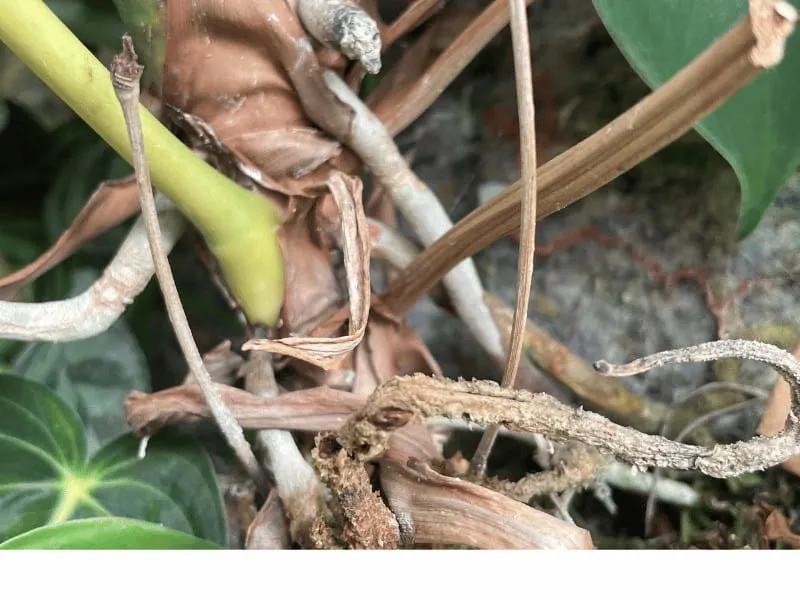
The benefit is that it is simple and it is working quite well. However, as the sphagnum moss contains no nutrients, it is important to fertilize regularly.
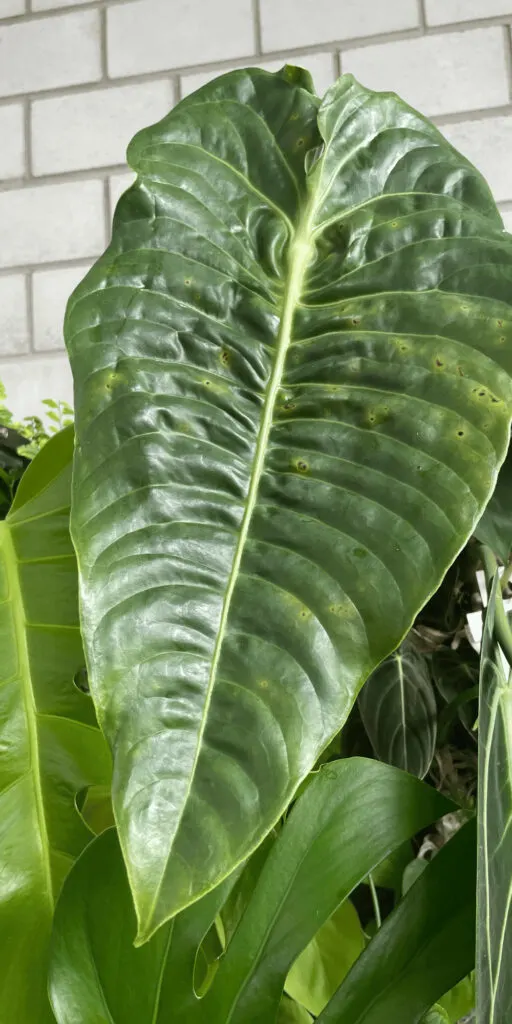
Light
Bright filtered light is best. Anthurium Veitchii is growing near the top of trees where it gets a lot of natural sunlight filtered through the treetops and leaves.
Avoid direct sunlight, as this can destroy the leaves of your houseplant.
A good window direction is an east-facing window. This window direction will get loads of indirect light throughout the day.
Read more about sunlight and window direction here.
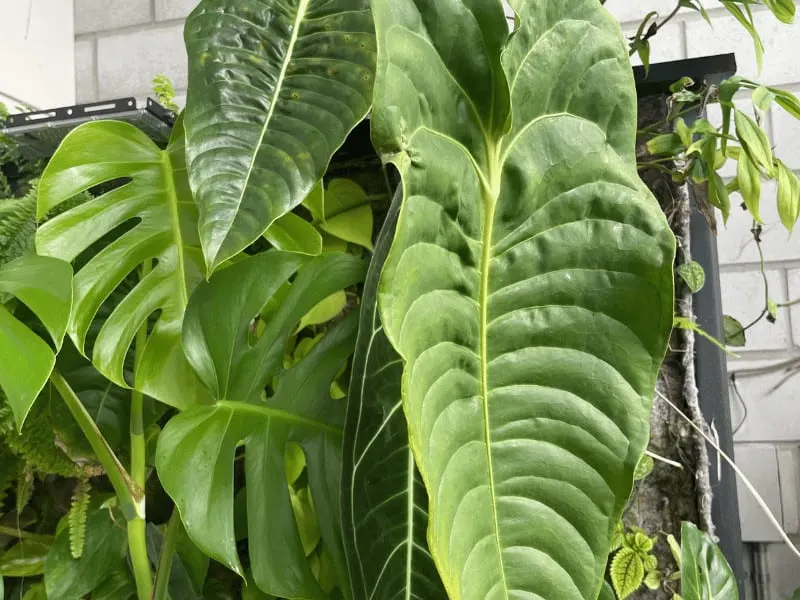
Watering
I water my Anthurium Veitchii once a week. However, depending on the soil medium you are using and the conditions your plant is growing in, you might have to water your plant more, less, or once a week.
You might have to water your plant less often if you grow your Veitchii in humid conditions with high air humidity.
Growing the King Anthurium in dry conditions and with a chunky soil mix will require much more frequent waterings.
I think you get the idea. Over time you will develop a rhythm of how often you need to water your indoor plants to keep them happy.
A good rule of thumb is always to check the medium before your water. Watering again is never a good idea if it is still pretty wet.
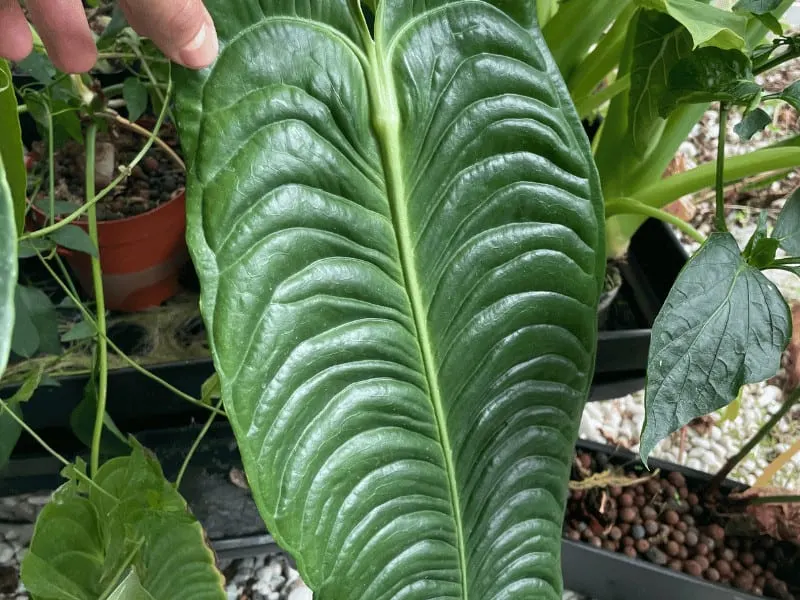
Temperature
Anthurium Veitchii grows best in cooler temperatures. A temperature range between 59°F (15°C) and 79°F (26°C) is a good choice.
Temperature below 59°F (15°C) for extended times is not tolerated by the Anthurium Veitchii. This is too cold.
The cooler months are the months when your Veitchii will grow the best.
Humidity
High humidity is a must when caring for Anthurium Veitchii. Keep the humidity above >60%.
It is important to allow for sufficient airflow simultaneously, as too much water on the leaves can damage them and lead to a bacterial infection.
There are multiple ways to increase the humidity of your plant:
Put your plants closely together: Putting plants close to each other will increase the humidity where the plants are placed.
Use a Pebble tray: The good old pebble tray filled with water below your plant’s pot is another good way to increase the humidity for the Anthurium Veitchii.
A humidifier: The best option is to use a humidifier from my point of view. I am personally using a Levoit Ultrasonic Humidifier.
It can be set up to a humidity of 80% and has an auto setting. Whenever the humidity drops below 80%, it will turn on and stop once 80% is reached.
To be exact, I think it has a 5% threshold. So once the humidity falls to 75%, it will turn on when setting it to 80%.
A closed plastic container: Keeping a certain humidity does neither have to be expensive or complicated. A single plastic container with a lid is sufficient to keep a constant high humidity for an extended time.
The only disadvantages are that it might not be extremely aesthetic on one hand, and depending on the size of your plant it might not be an option.
I personally spray a few times into the container, put some Sphagnum moss in it, and then close the lid entirely.
I will open it every few days to allow for air exchange and to prevent the air becomes stagnant. This keeps the humidity at 90% and above for weeks.
A terrarium: A terrarium or bioactive vivarium is a fantastic way to keep your tropical plants happy.
Depending on the size of the terrarium you can accommodate in your home (especially if the height is relevant), this can be a fantastic solution.
It is much easier to create a climate and proper conditions without you having to live in a tropical jungle in your four walls yourself.
If you are serious about keeping your Anthurium Veitchii in the best conditions possible using high humidity, the best options are a terrarium, a closed container, or a humidifier, in my personal opinion.
As Anthurium veitchii can grow large in leaf size, the humidifier used in your room or an indoor grow tent is often the best option.
Fertilizer
I use a well-balanced fertilizer once a month in Spring and Summer. I refrain from fertilizing in Autumn and Winter.
Anthurium plants are often said to need little fertilizer. They are epiphytes and must survive with the little nutrients they get from wind, water, and debris in tree branches.
I disagree as I think frequent fertilization is key to keeping your indoor plants happy and for them to grow towards their full potential in size.
This also applies to the Anthurium Veitchii.
In addition, you don’t have debris and leaf litter at home, and the winds won’t bring any nutrients either.
So I suggest a water-soluble fertilizer with NPK values 9-3-6 or 12-12-12 that you use every second watering.
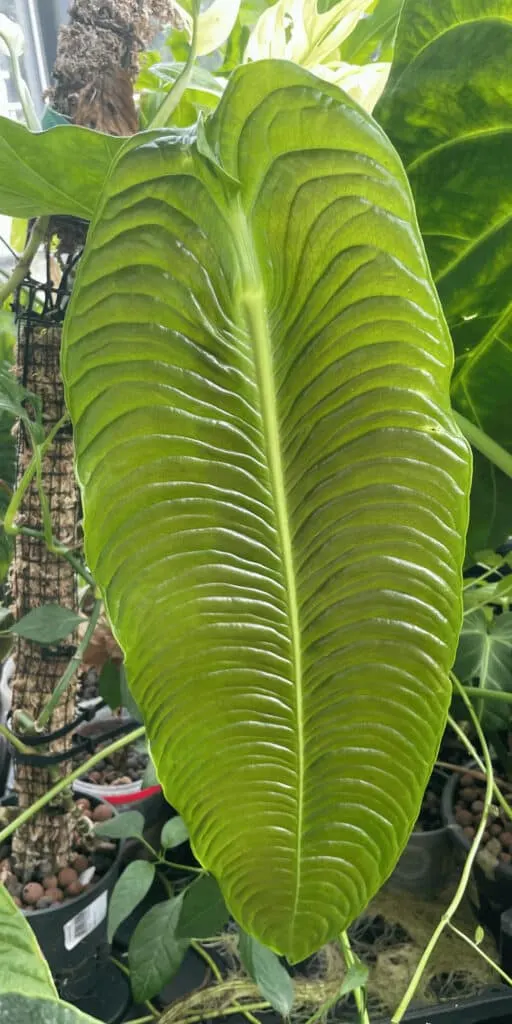
How to Propagate Anthurium veitchii
There isn’t much information on how to best propagate an Anthurium Veitchii.
The most viable option, from my experience, is to stem-propagate Anthuriums. This means cutting off a section of the stem of your plant with nodes and roots.
Other options are seed and tissue-cutting propagation. The first one will require you to have a pollinated plant that produces seeds, and the second one requires laboratory equipment.
So the best and easiest method is taking a stem cutting from your Anthurium Veitchii.
Growth
The Anthurium Veitchii is growing as slow as molasses for me. This is not a plant playing in the one-leaf-a-month club.
My plant produces a new leaf about every three months max. This easily makes it the slowest-growing plant in my collection besides the cacti I own.
However, we have to consider its full potential. The Anthurium Veitchii is said to grow leaves bigger than life.
The leaves can grow up to 6.6 feet (2 meters). This is likely taller than you, assuming you are not playing in the NBA.
Potting
If you want to provide the best care possible for your Anthurium Veitchii, provide your plant with an Orchid basket.
Orchid baskets are the closest thing to growing in tree branches. The plants can attach their roots to the wood.
Furthermore, the space between the wood is perfect to allow for sufficient airflow.
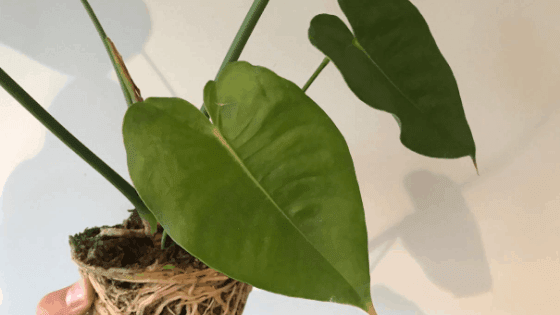
Anthurium veitchii Flower
The Anthurium veitchii inflorescence consists of a spathe and spadix. The spathe is a modified leaf. The spadix is like an upright stick in the center containing tiny flowers. So the inflorescence itself is not the flower.
The flower goes through a female phase, where it is receptive, and then a male phase. In the female phase it produces sticky drops that can take on pollen. Pollen is produced in the male phase.
The King Anthurium does not always go through both phases and might skip one phase.
The following is a picture of my blooming King Anthurium. It was blooming in May. Unfortunately, I could not pollinate it successfully.
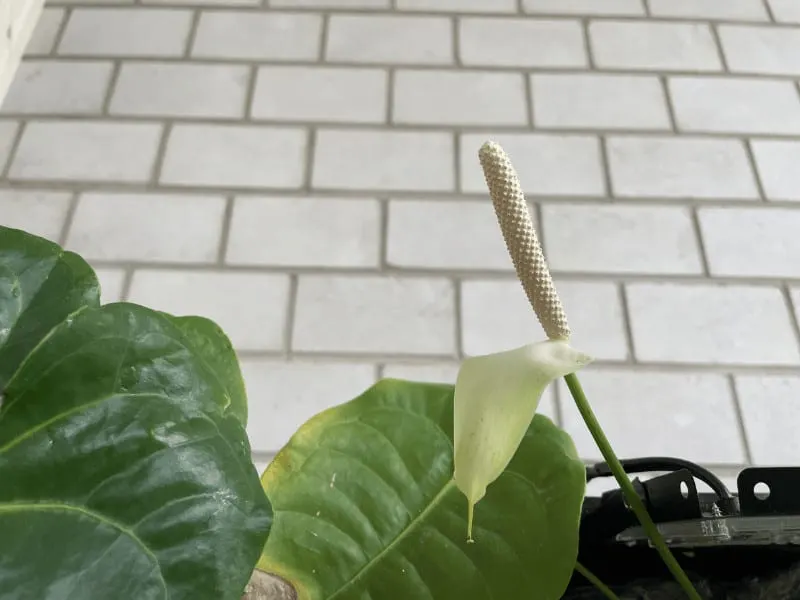
Here is my article about Philodendron and Monstera pollination. The steps are the same for Anthuriums.
Anthurium veitchii Propagation
I am no expert in Anthurium propagation, but how these plants can be propagated is similar to most aroids. The most straightforward way is to take stem cuttings.
Ensure that you have a node and hopefully already a few roots of air roots, as this will make the propagation process quicker and increase the probability of success.
Another way of propagating this plant is by stem division. This will highly depend on how bushy your plant already is and how big the cluster of stems has developed.
Last but not least are Micropropagation and course, the propagation from seeds.
The challenge with seeds is that they are very hard to get, and the chance of getting scammed online is high.
A good rule of thumb is to never buy seeds online, at least for now. It might be different ten years down the road, but as of now, this is rarely a good idea.
Most seeds are good for feeding birds, or if you like to watch grass grow, know yourself out on the opportunity.
Let’s get back to the seeds thing. So we learned that you may have to produce your seeds.
You must pollinate your plant, which requires two blooms simultaneously, or you freeze pollen to propagate a blooming Anthurium Veitchii.
A big advantage, according to the University of Hawaii, is that the propagation from seeds will not produce exact clones and will lead to a lot of variation in terms of color, texture, size, and flower.
A whole different ballgame is micropropagation. You do not need to be a scientist or have a laboratory, but you will need laboratory equipment to keep everything sterile.
Anthurium Veitchii is known for being cloned, or micro propagated, making it more readily available and affordable.
You can conclude from this section that taking stem cuttings is probably the way to go (unless you can divide the plant).
Here is a step-by-step tutorial on propagating an Anthurium Veitchii by stem propagation:
- Find a section on your plant that you can propagate. You will need at least one node
- If you can identify a section with roots or air roots and a leaf, even better
- Get your pruning shears or knife ready
- Disinfect the blade using rubbing alcohol and hold it under a flame for a few seconds. This will avoid passing on any pathogens or diseases.
- Take a clean cutting and use cinnamon on the wounds to distinct and protect the wounds.
- Put your cutting in Sphagnum moss or water and wait for the roots to grow.
- Within 3-4 weeks, you should see roots starting to grow.
- Wait until the roots are at least several inches long, and put them into the potting medium of your choice
- You have just cloned your plant. A perfect clone of your mother plant has been created.
The next section will examine the most common problems with Anthurium veitchii grown as an indoor plant.
Common Problems with Anthurium veitchii
Damaged leaves
Damaged leaves are a problem with Anthurium Veitchii.
Leaves get damaged easily, and when touching other objects or plants often get damaged and will show little cracks or deformations.
A different reason for damaged leaves can be humidity. The lack of sufficient humidity at least 60% and above often leads to leaf damage.
The reason is that the leaves do not properly emerge from the cataphyll. It is almost like a dry birth.
The humidity acts somewhat like a lubricant to help the new leaf emerge and grow.
So what you can learn from this is to leave new leaves alone, have sufficient humidity, and make sure they are not touching anything else until they are hardened off.
Another reason for perforation and tears in leaves can be too much air movement.
Leaves should be allowed to develop away from excessive air movement. So keep your fans at bay and ensure the Veitchii is not above a radiator or heater.
Anthurium veitchii Pests
As with all indoor and outdoor plants, Pests are one of the things you have to deal with from time to time.
I can say, fingers crossed, that I have found Anthurium plants less prone to pest infestations than Monstera and Philodendron plants.
I didn’t have a single infestation on my Anthurium Veitchii. The most common pests that attack our houseplants are Whiteflies, Scale, Mealybugs, Thrips, and the nasty Spider Mites.
The best thing you can do is to detect infestations early. By checking on your plants and looking at the underside of leaves on your Anthurium Veitchii, chances are high that you will spot a pest problem early on.
When confronted with pests, these are the weapons that helped me to win the most battles against plant bugs:
- Castille Soap
- Neem Oil
- Spray water on the leaves with high pressure
You are welcome.
Why does my Anthurium veitchii have yellow leaves?
Yellow leaves are mostly a sign of overwatering. Check the potting soil and ensure it is not soggy. If the soil is too compacted your Anthurium can develop root rot.
To confirm if it is root rot, check if the roots are mushy and brown to black. Healthy roots are a pale brown to white.
Other reasons include underwatering, pests, too much fertilizer, or direct sunlight.
What are the brown and yellow spots on my King Anthurium?
The King Anthurium is prone to bacterial infections such as bacterial blight or Leaf spot diesease. Bacteria and fungi build up mostly when the leaves stay wet for too long.
Ensure your Veitchii King has sufficient airflow. Leaves should dry completely within 30 minutes.
Tips to keep the King Anthurium problem-free
This section summarizes the most important points related to Anthurium Veitchii care.
Keep the humidity above >60% to ensure new leaves are not damaged once they emerge from the cataphyll.
Anthurium Veitchii is a cold grower and grows best in temperatures between 59°F (15°C) to 79°F (26°C)
The best soil mixture is an airy mix of orchid bark, perlite, and peat moss. Alternatively, you can use 100% Sphagnum Moss.
Fertilize every two weeks using a liquid fertilizer with a concentration of NPK values 9-3-6 or 12-12-12.
A pot that allows for air circulation is best. Use a cachepot or an Orchid basket.
Now we can move over to the most frequently asked questions about Anthurium Veitchii care.
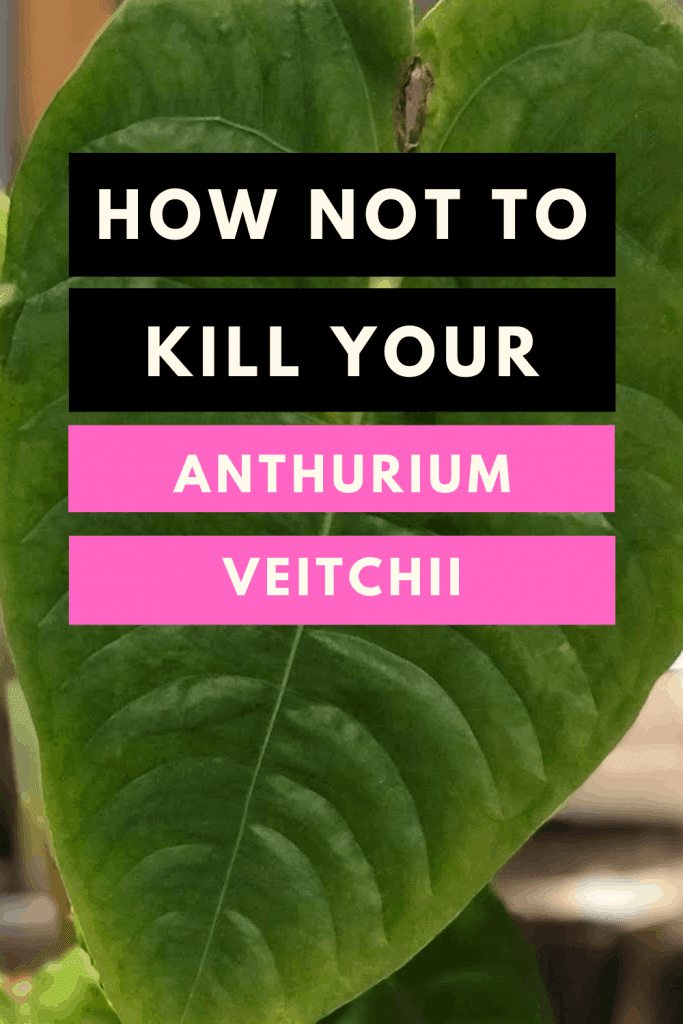
Anthurium veitchii narrow vs. veitchii wide form
The Anthurium veitchii narrow has narrower leaves that are more corrugated. The leaves look like abs. The Anthurium veitchii wide form has less ribs and wider leaves that are less narrow.
Here are pictures of both my Anthurium veitchii wide and narrow form for comparison:
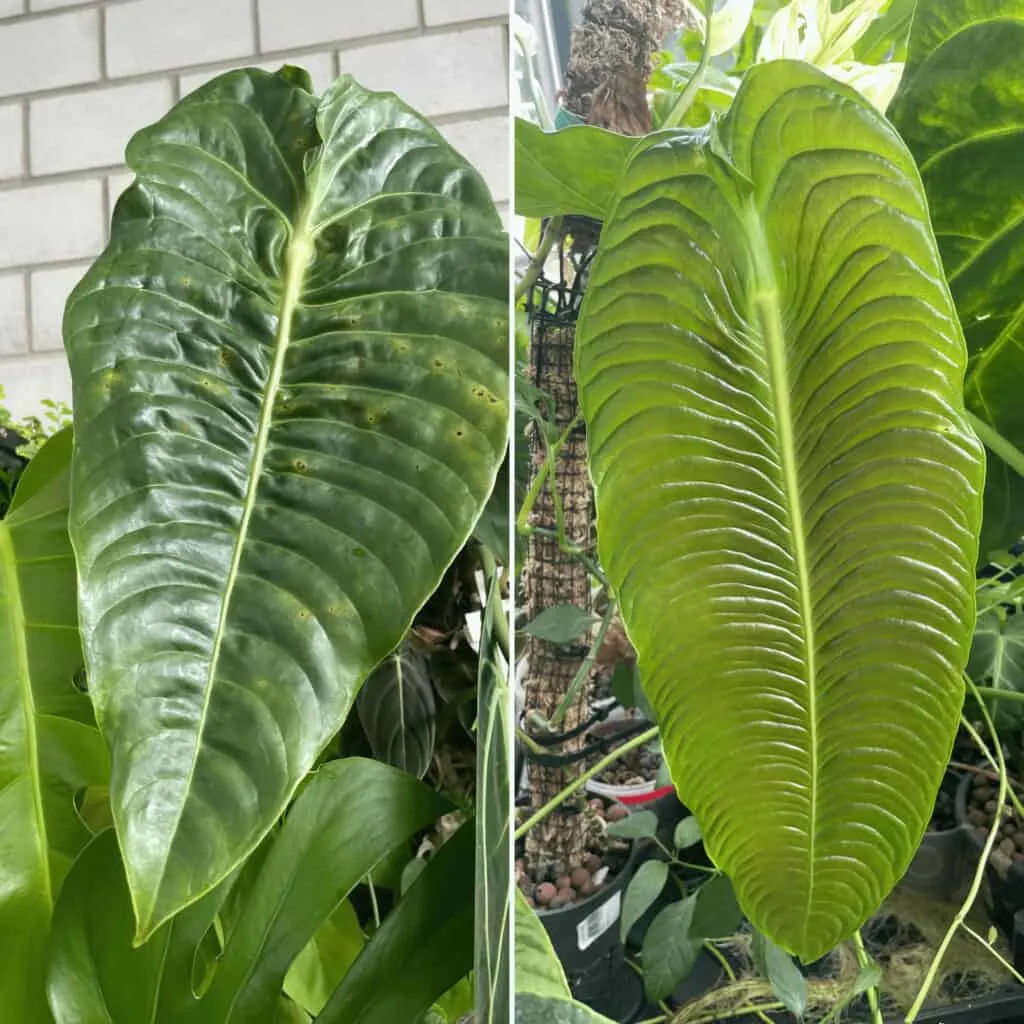
Anthurium veitchii for sale
You can buy an Anthurium veitchii in the following shops online:
- NSE Tropicals
- Etsy
- Amazon (You can get an Anthurium veitchii starter plant)
Is Anthurium veitchii toxic?
Anthurium veitchii is toxic to cats and dogs as well as humans. It contains insoluble calcium oxalate chrystals, according to Pet Poison hotline.
Read more about Anthurium toxicity.
Frequently asked questions about the Anthurium Veitchii
Why is my Anthurium Veitchii growing so slowly?
Anthurium Veitchii is a very slow grower. It takes approximately 3 months for a new leaf to develop.
Why are the leaves of my Anthurium Veitchii torn?
Torn leaves can be caused by insufficient humidity, too much airflow, objects, and other plants touching the Anthurium Veitchii.
Why are the leaves of my Anthurium Veitchii getting smaller?
When the leaves on your Anthurium Veitchii are getting smaller you need to check how often you fertilize your plant. Fertilizing every other week is a good rule of thumb.
How much humidity does the Anthurium Veitchii need?
Keep the humidity above 60% at all times. The higher the humidity, the better for your Anthurium Veitchii.
What is the best potting mix for an Anthurium Veitchii?
A general aroid potting mix using chunky material such as orchid bark, perlite, and peat moss is best. Alternatively, you can use 100% Sphagnum moss.

Daniel has been a plant enthusiast for over 20 years. He owns hundreds of houseplants and prepares for the chili growing seasons yearly with great anticipation. His favorite plants are plant species in the Araceae family, such as Monstera, Philodendron, and Anthurium. He also loves gardening and is growing hot peppers, tomatoes, and many more vegetables.

